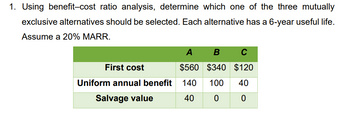
ENGR.ECONOMIC ANALYSIS
14th Edition
ISBN: 9780190931919
Author: NEWNAN
Publisher: Oxford University Press
expand_more
expand_more
format_list_bulleted
Question

Transcribed Image Text:1. Using benefit–cost ratio analysis, determine which one of the three mutually exclusive alternatives should be selected. Each alternative has a 6-year useful life. Assume a 20% Minimum Acceptable Rate of Return (MARR).
**Table: Alternative Analyses**
| | A | B | C |
|------------|------|------|------|
| **First cost** | $560 | $340 | $120 |
| **Uniform annual benefit** | 140 | 100 | 40 |
| **Salvage value** | 40 | 0 | 0 |
- The table compares three investment alternatives (A, B, and C) based on their first cost, uniform annual benefit, and salvage value.
- Each investment alternative has a 6-year useful life and is evaluated with a 20% MARR to identify the best option.
Expert Solution
arrow_forward
Step 1
Cost-benefit analysis is a method for contrasting the expenses and advantages of an intervention, where both are communicated in monetary units. Both Cost-benefit analysis and cost-effectiveness analysis (CEA) incorporate health outcomes.
Step by stepSolved in 2 steps with 1 images

Knowledge Booster
Learn more about
Need a deep-dive on the concept behind this application? Look no further. Learn more about this topic, economics and related others by exploring similar questions and additional content below.Similar questions
- Hand written solutions are strictly prohibitedarrow_forwardQ#2 Graph the EUAC or EUAB of the following two mutually exclusive alternatives. Use interest rate from 0% to 100% Initial cost Annual Cost HP Dell 6800 16,999 1500 1800 Annual Benefits 4000 5500 Salvage Value Useful Life in years 1000 35000 4 8arrow_forwardCan someone help me to solve this problem using the present worth analysis? Using neatly written hand calculations. PLEASE AND THANK YOU!!!!arrow_forward
arrow_back_ios
arrow_forward_ios
Recommended textbooks for you

 Principles of Economics (12th Edition)EconomicsISBN:9780134078779Author:Karl E. Case, Ray C. Fair, Sharon E. OsterPublisher:PEARSON
Principles of Economics (12th Edition)EconomicsISBN:9780134078779Author:Karl E. Case, Ray C. Fair, Sharon E. OsterPublisher:PEARSON Engineering Economy (17th Edition)EconomicsISBN:9780134870069Author:William G. Sullivan, Elin M. Wicks, C. Patrick KoellingPublisher:PEARSON
Engineering Economy (17th Edition)EconomicsISBN:9780134870069Author:William G. Sullivan, Elin M. Wicks, C. Patrick KoellingPublisher:PEARSON Principles of Economics (MindTap Course List)EconomicsISBN:9781305585126Author:N. Gregory MankiwPublisher:Cengage Learning
Principles of Economics (MindTap Course List)EconomicsISBN:9781305585126Author:N. Gregory MankiwPublisher:Cengage Learning Managerial Economics: A Problem Solving ApproachEconomicsISBN:9781337106665Author:Luke M. Froeb, Brian T. McCann, Michael R. Ward, Mike ShorPublisher:Cengage Learning
Managerial Economics: A Problem Solving ApproachEconomicsISBN:9781337106665Author:Luke M. Froeb, Brian T. McCann, Michael R. Ward, Mike ShorPublisher:Cengage Learning Managerial Economics & Business Strategy (Mcgraw-...EconomicsISBN:9781259290619Author:Michael Baye, Jeff PrincePublisher:McGraw-Hill Education
Managerial Economics & Business Strategy (Mcgraw-...EconomicsISBN:9781259290619Author:Michael Baye, Jeff PrincePublisher:McGraw-Hill Education


Principles of Economics (12th Edition)
Economics
ISBN:9780134078779
Author:Karl E. Case, Ray C. Fair, Sharon E. Oster
Publisher:PEARSON

Engineering Economy (17th Edition)
Economics
ISBN:9780134870069
Author:William G. Sullivan, Elin M. Wicks, C. Patrick Koelling
Publisher:PEARSON

Principles of Economics (MindTap Course List)
Economics
ISBN:9781305585126
Author:N. Gregory Mankiw
Publisher:Cengage Learning

Managerial Economics: A Problem Solving Approach
Economics
ISBN:9781337106665
Author:Luke M. Froeb, Brian T. McCann, Michael R. Ward, Mike Shor
Publisher:Cengage Learning

Managerial Economics & Business Strategy (Mcgraw-...
Economics
ISBN:9781259290619
Author:Michael Baye, Jeff Prince
Publisher:McGraw-Hill Education